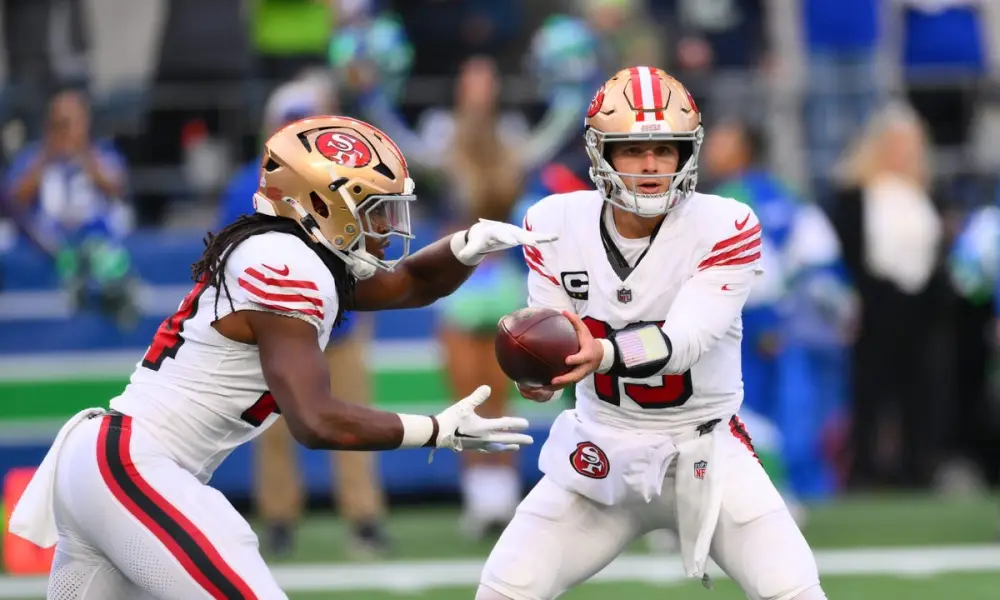
Quick Slant: SNF - Two Legacy Franchises Try to Avoid Oblivion
Cowboys @ 49ers, Sunday @ 8:20 PM
In the post-merger NFL annals, few teams loom as large as the Dallas Cowboys and the San Francisco 49ers. Together, they account for ten total Super Bowl victories and 16 appearances, representing over 27% of the NFC’s total appearances and 34% of its championships. Between 1981 and 1995, they appeared in eight of 15 Super Bowls, winning each. From 1992 to 1994, they played three consecutive NFC Championship games, with the winner going on to win the subsequent Super Bowl by an average margin of 25 points per game. They are bonded by nine playoff matchups – tied for the second-most by any two teams. Since their founding, they rank first and second all-time in Hall of Famers per season, including Charles Haley and Deion Sanders, who played for each. Another starter – Ken Norton, Jr. – won championships wearing both team’s laundry. And from George Kittle’s NSFW under-jersey tee-shirts to George Teague spearing Terrell Owens for dancing on the Cowboys’ mid-field logo, this rivalry has always had some spice.
These two teams’ histories are intrinsically tied; this year, they seem tied to an anchor. And yet, each proud franchise has more to play for whenever they look upon the colors of the other. The hate, as they say, runs deep.
Cowboys’ Implied Team Total: 21.5
The Cowboys emerge from the bye 24th in EPA per play and 22nd in offensive success rate. Last year, they ranked 2nd in EPA per play and third in offensive success rate. It is not the most significant offensive decline from last season to this, but it is the most significant without clear and obvious misfortune driving it.
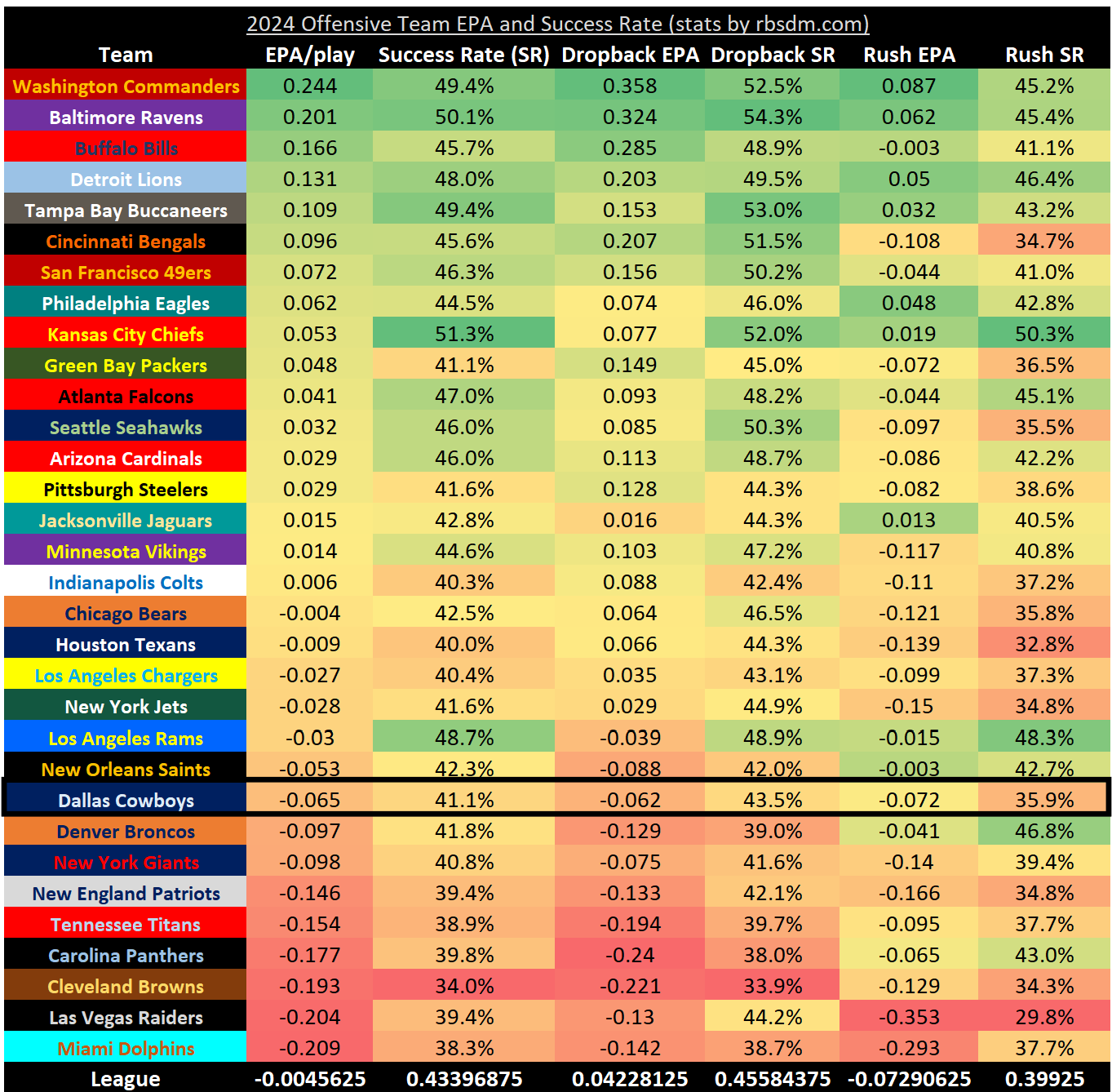
The Cowboys are at a crossroads. They probably missed their championship window (that is, of course, if it ever existed); their offensive line – long a strength – has begun to age out. They’ve planted seeds like Tyler Smith and Tyler Guyton, but thus far, they can’t measure up to what once was. Meanwhile, rather than tear the whole thing down to the studs, the Cowboys are trying to stay relevant; presumably, they plan to invest in Dak Prescott, CeeDee Lamb, Micah Parsons, and Trevon Diggs and quickly rebuild around them. Because of the pronounced expense these four players come with, the Cowboys aren’t liquid and aren’t good enough to win today. We wait to see if they can win tomorrow.
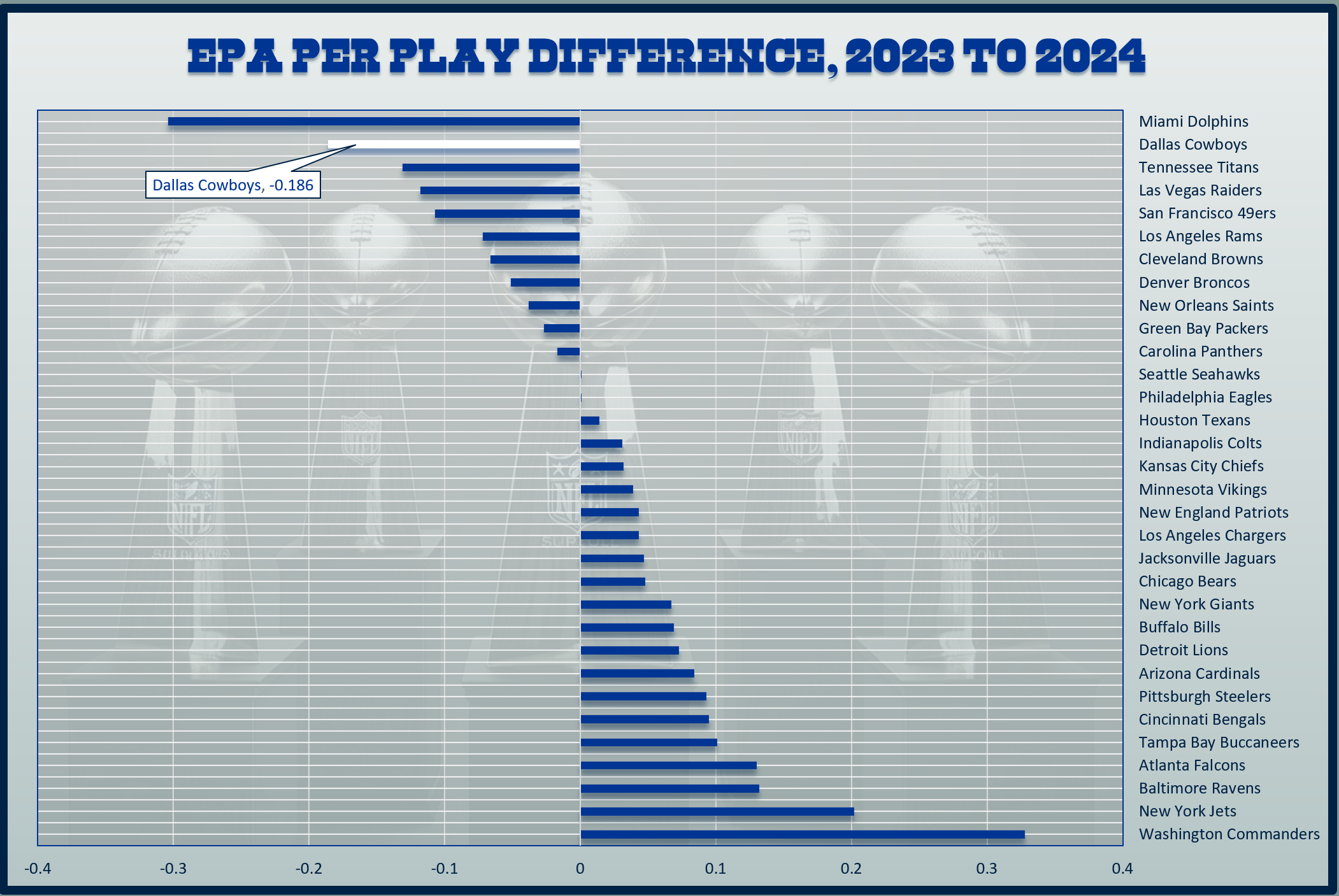
Dak Prescott leads the Cowboys and is now the highest-paid quarterback in the NFL after signing a $240 million contract worth about $60 million per year this summer.
So far, Prescott has had one excellent fantasy game - Week 3, against Baltimore, where most of his production came in garbage time in a rout at the Cowboys' expense. His efficiency is low at -6.2 total fantasy points over expected (FPOE) and -5.0 passing FPOE, the first occasion in Prescott's career where he's had a negative value.
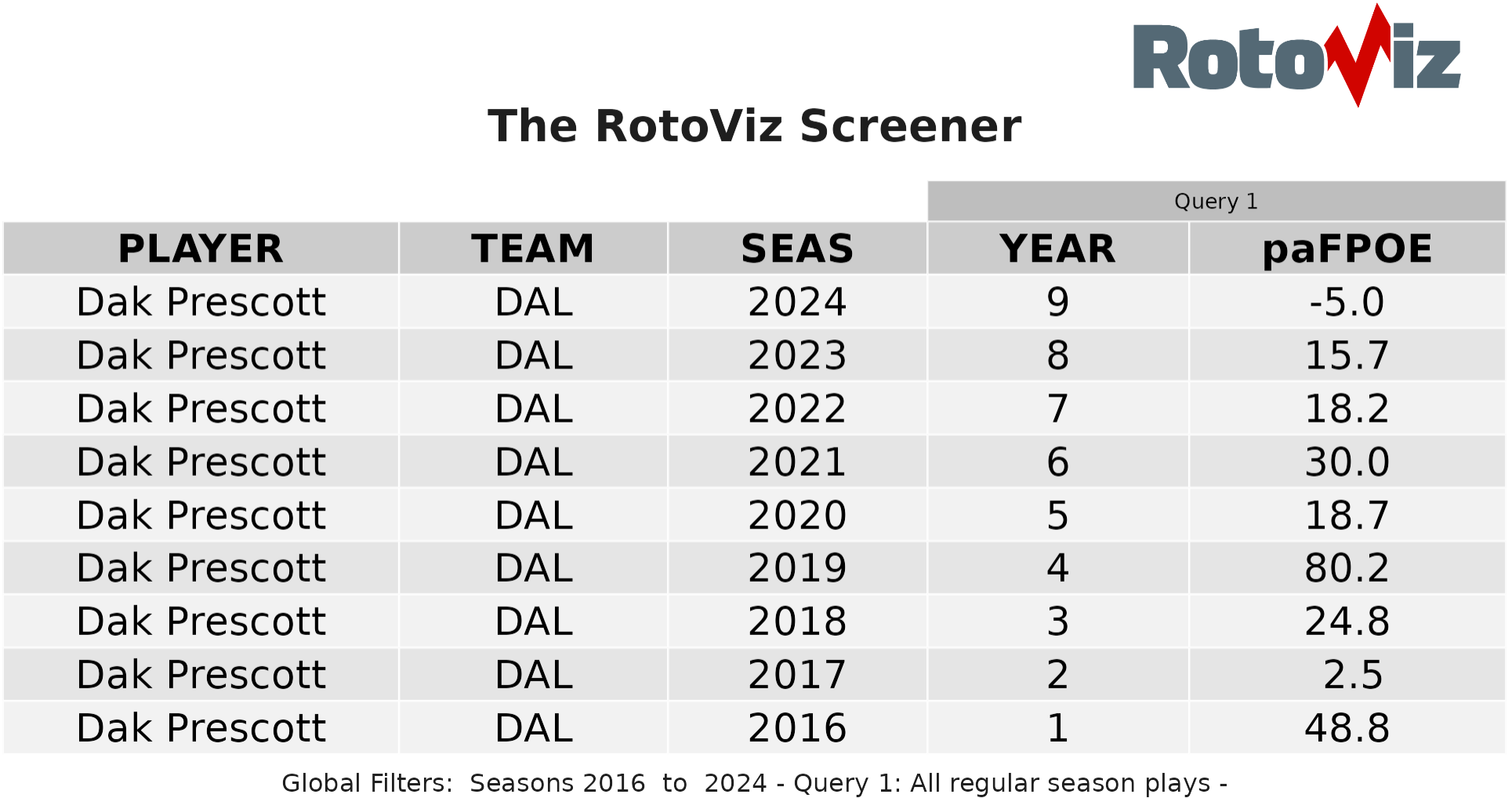
Dallas tries to push the pace—they have the lowest seconds to snap at 23.2 and are tied with two teams for most offensive plays per 60 minutes. This, along with the league’s eighth-highest pass rate over expected, has afforded Prescott the second-most attempts per game among quarterbacks with at least 100 dropbacks at 37.3. Despite his high volume, Prescott has lagged in Y/A and completion percentage and has the worst QBR of his career thus far. He ranks 25th in EPA + CPOE Composite.
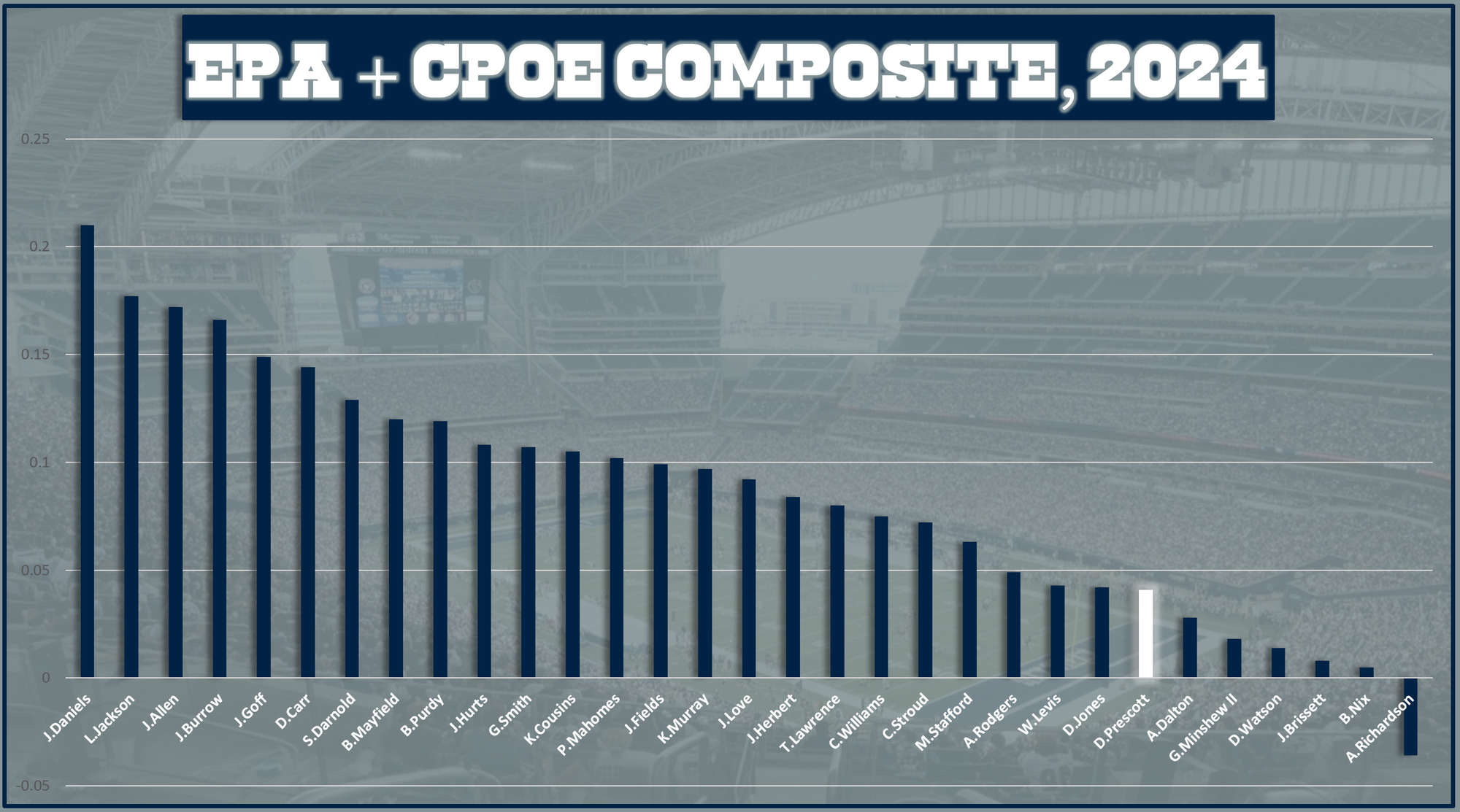
Part of the issue for Dallas is they can’t keep drives going. They rank 9th in fourth downs per game and 27th in fourth down conversion percentage. They rank 21st in first downs per play and 29th in time of possession. Their opponents have run long, sustained, usually successful drives; opponents have maintained an average of 28.5 seconds to snap, tied for third-highest, and led by seven or more points for 149 total plays, tied for fourth most.
If there is one nugget of hope for Dallas’ offense, it is that they started in an eerily similar way last season only to pull it together (although the Cowboys' total functionality was better to this point). Prescott was deemed a sinking stone by the same Week 7 bye a year ago; he came out the other side and remade himself as a legitimate MVP candidate.
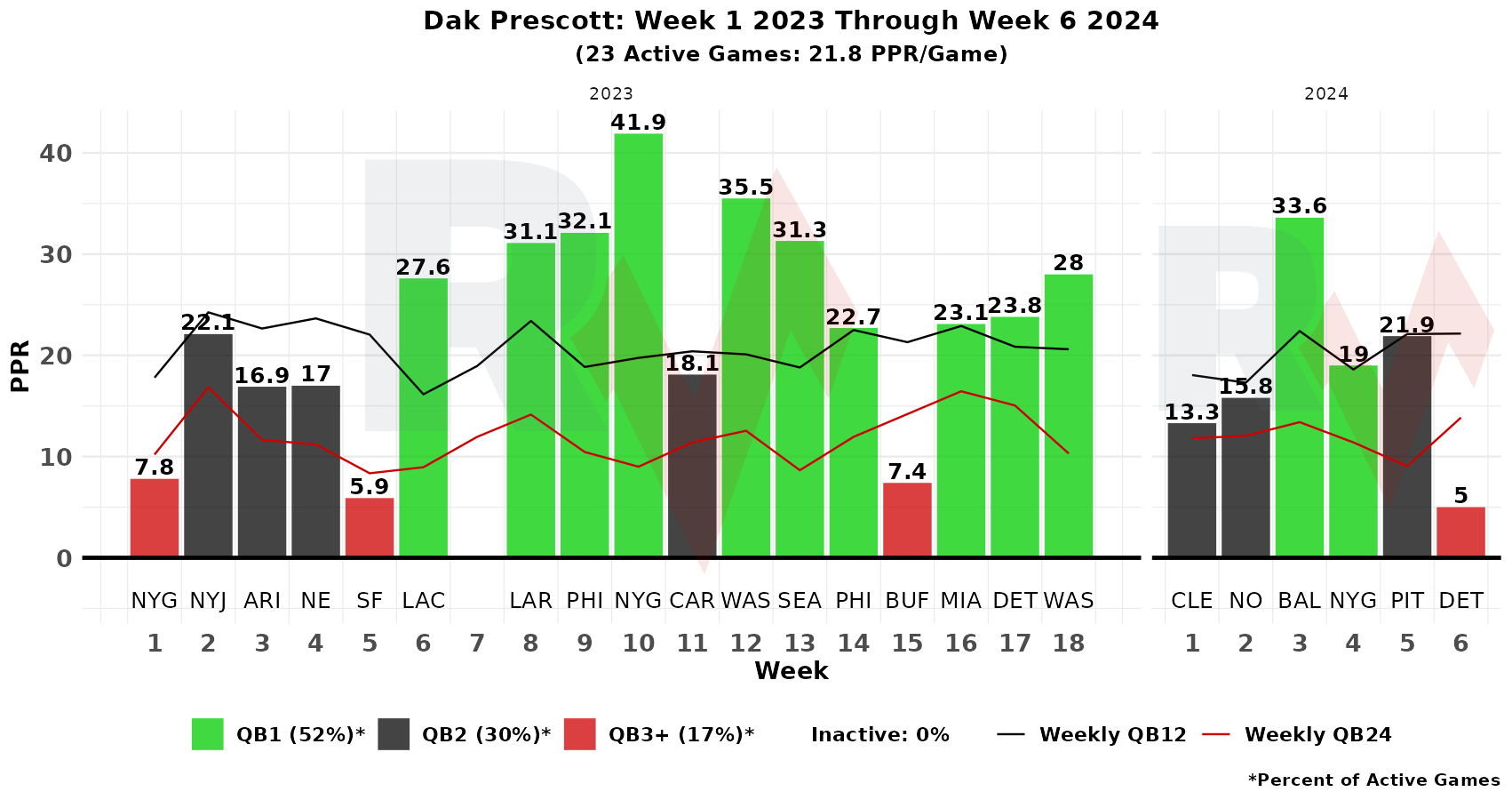
The Cowboys’ offensive line has surrendered the fifth-worst pressure rate over expected. The 49ers rank in the league's top half in defensive pressure rate over expected. San Francisco's expectation should be that it will be able to produce pressure, even with Guyton, the Cowboys’ first-round pick, expected to return from injury.
Even so, Prescott spends just 30.2% of his dropbacks under pressure, which is 31st in the league. He also handles pressure better than most, partly because of his quick release (Prescott ranks eighth in time to throw); his QB Rating is only nine points lower when pressured than when clean, one of the more minor disparities in the league. Unfortunately, the problem for Prescott is not simply explained away by pressure levels; it persists all the time.
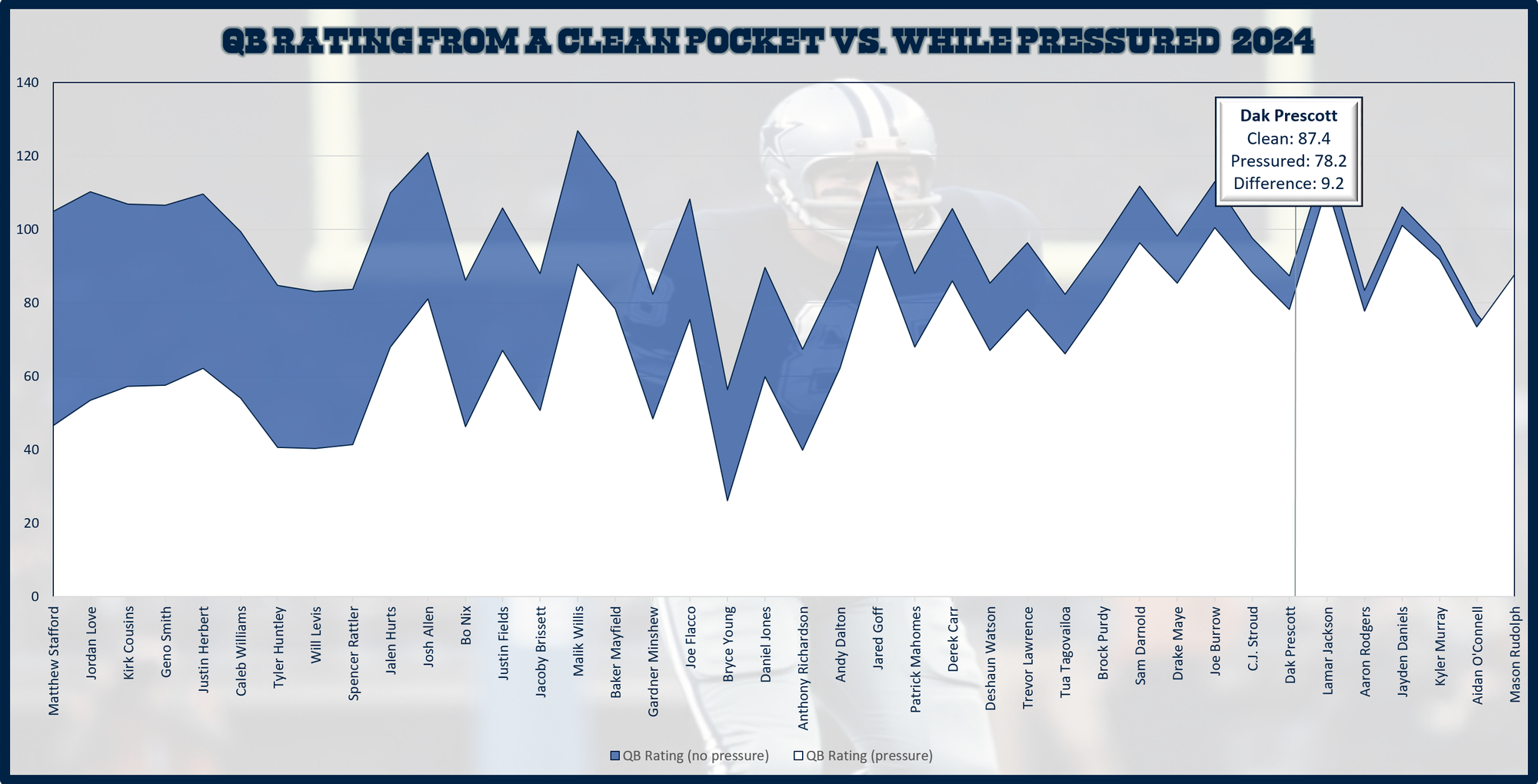
The silver lining is that Prescott has a long track record; his historical efficiency has always been better than this, and we would expect it to normalize somewhat. He is already getting a good amount of opportunity. The fact that his defense is down is not a deterrent in fantasy football. As such, a second-half surge similar to last season is not out of the question.
Prescott's decreased performance may be due to the decline of his receiving corps, which has fallen nearly five FPOE per game since last year. This is a chicken-egg scenario, and it is difficult to know what is at the root of the failure.

His primary target in 2024 is still CeeDee Lamb, although his market share is down six percent from last year. The only other passing game options with at least 15% are TE Jake Ferguson and oncoming third-year WR Jalen Tolbert.
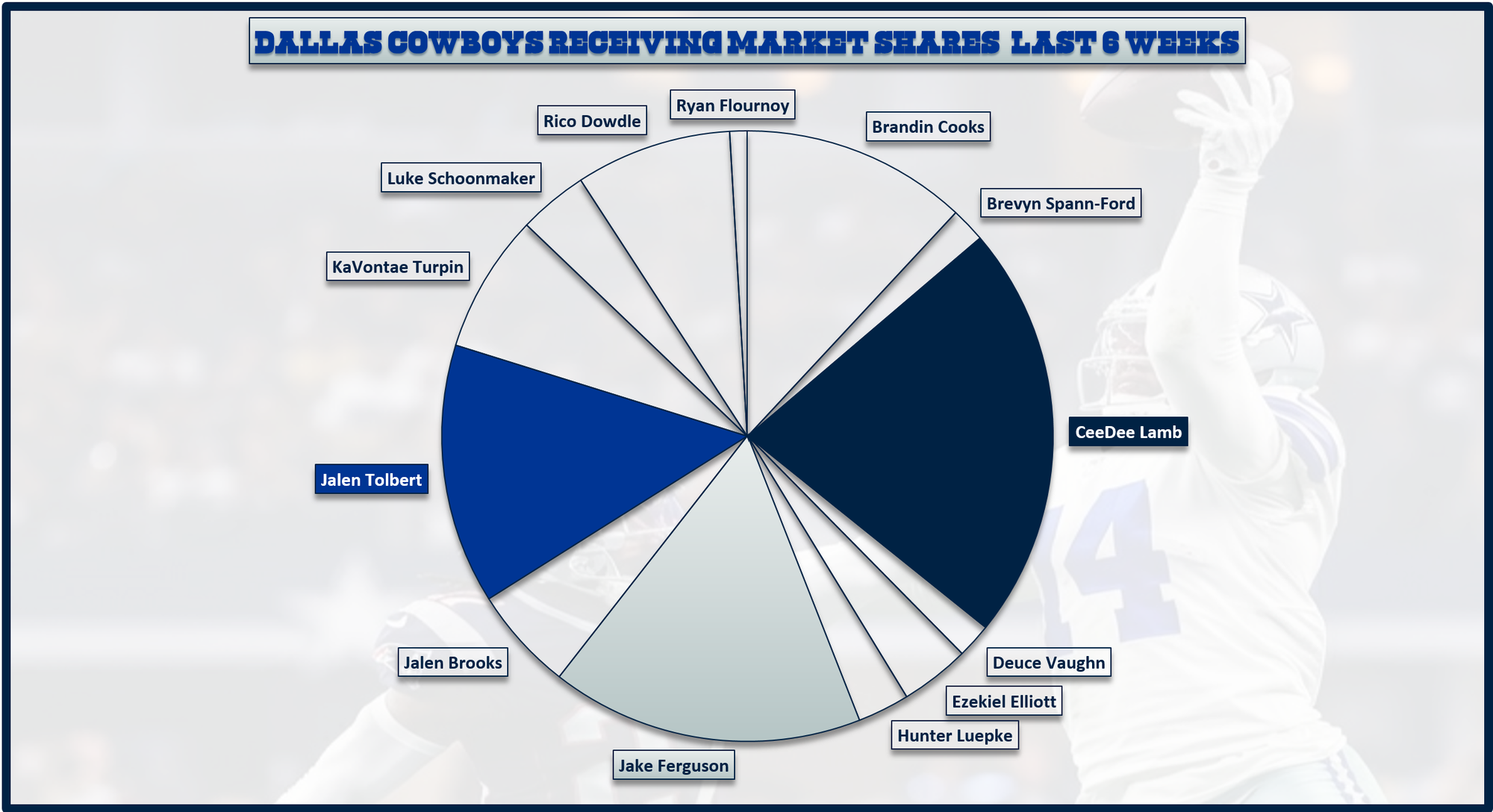
Lamb has drawn more opportunity to this point than he had last year. However, he had only one outing with ten or more targets through six weeks in 2023; he has two so far in 2024. After the bye a year ago, he had ten targets in 11 of 13 outings.
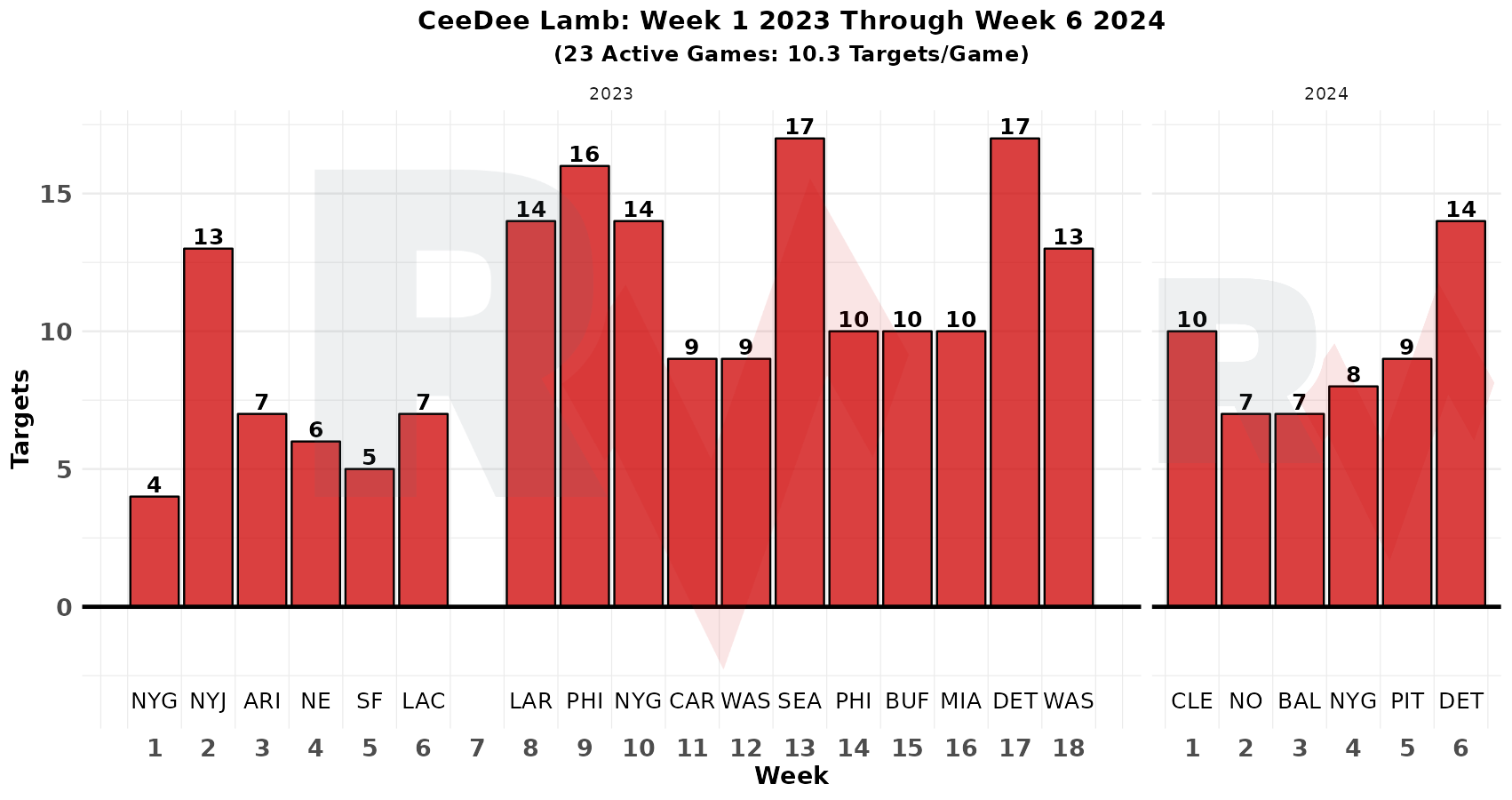
One substantial difference between last year and this year is Lamb’s efficiency, which is about as low as ever for a sustained amount of time. Last year, Lamb had negative FPOE only twice all year. This year, he has done that four times in just six games.
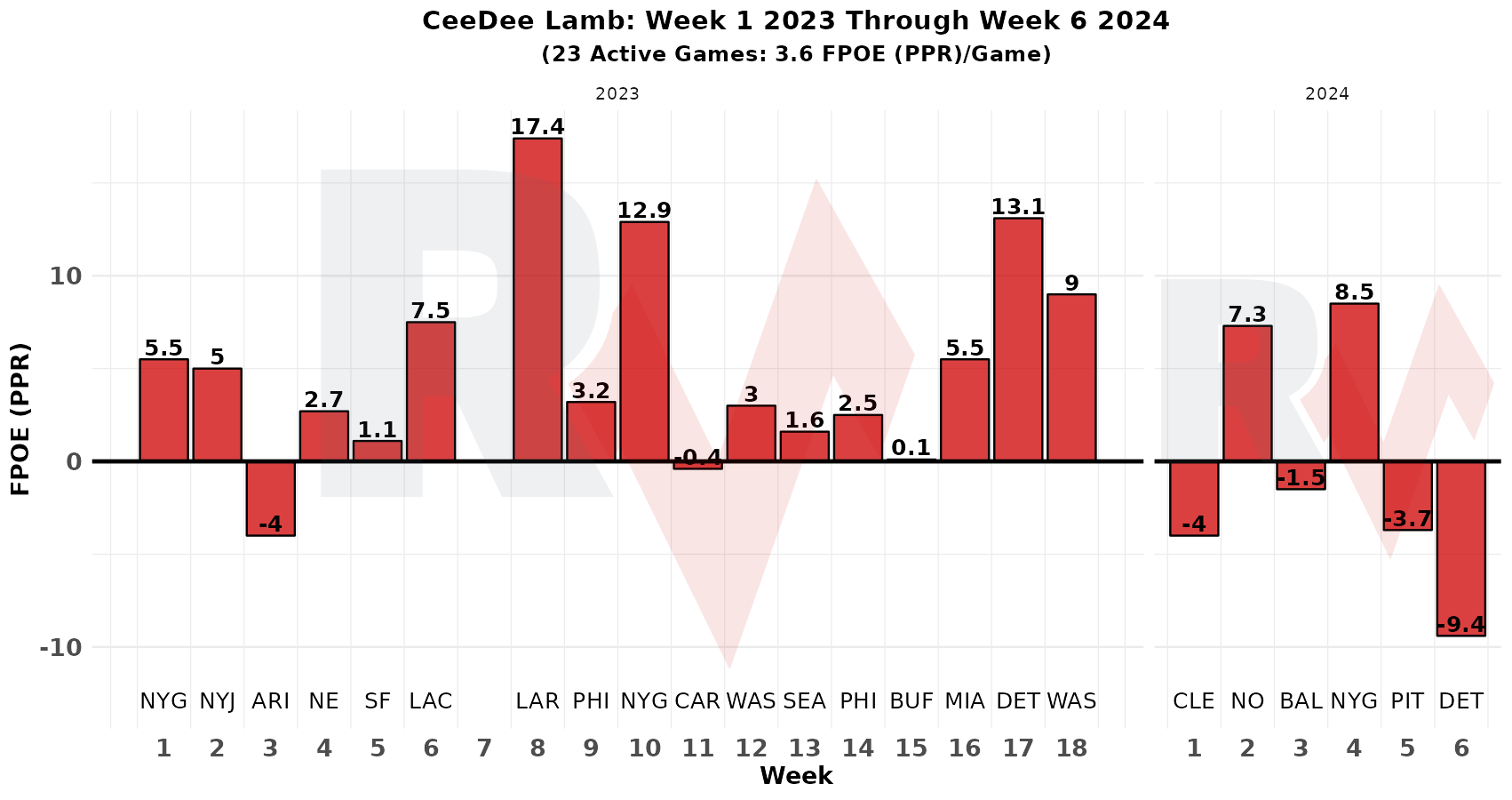
Again, chicken/egg.
Ferguson was off to an incredible start. His EP/G was first in the league after four weeks. At this point, he is down to sixth. Tolbert has been efficient, but his market share is still low for a fantasy WR. He’s only for deep leagues. Brandin Cooks is still out with a knee infection; for now, the market shares will probably remain similar to what we’ve already seen in Big D.
The 49ers run about league average in zone and man coverage, meaning they still spend over twice as much time in zone as they do man. They almost spend equal parts in Cover 1, Cover 3, and Cover 4. Their 21.7% quarters is the fifth-highest rate in the league.
The types of coverages the 49ers utilize make a poor matchup for the Cowboys’ pass catchers. They are also reasonably good at what they do, ranking 10th in EPA per dropback allowed and allowing the 12th-fewest fantasy points per dropback. This is foreboding for the Cowboys’ pass catchers, top to bottom. This is not the best spot for any significant Cowboys’ pass-catcher, nor Prescott. San Francisco also allows the 11th fewest fantasy points per dropback to QBs.
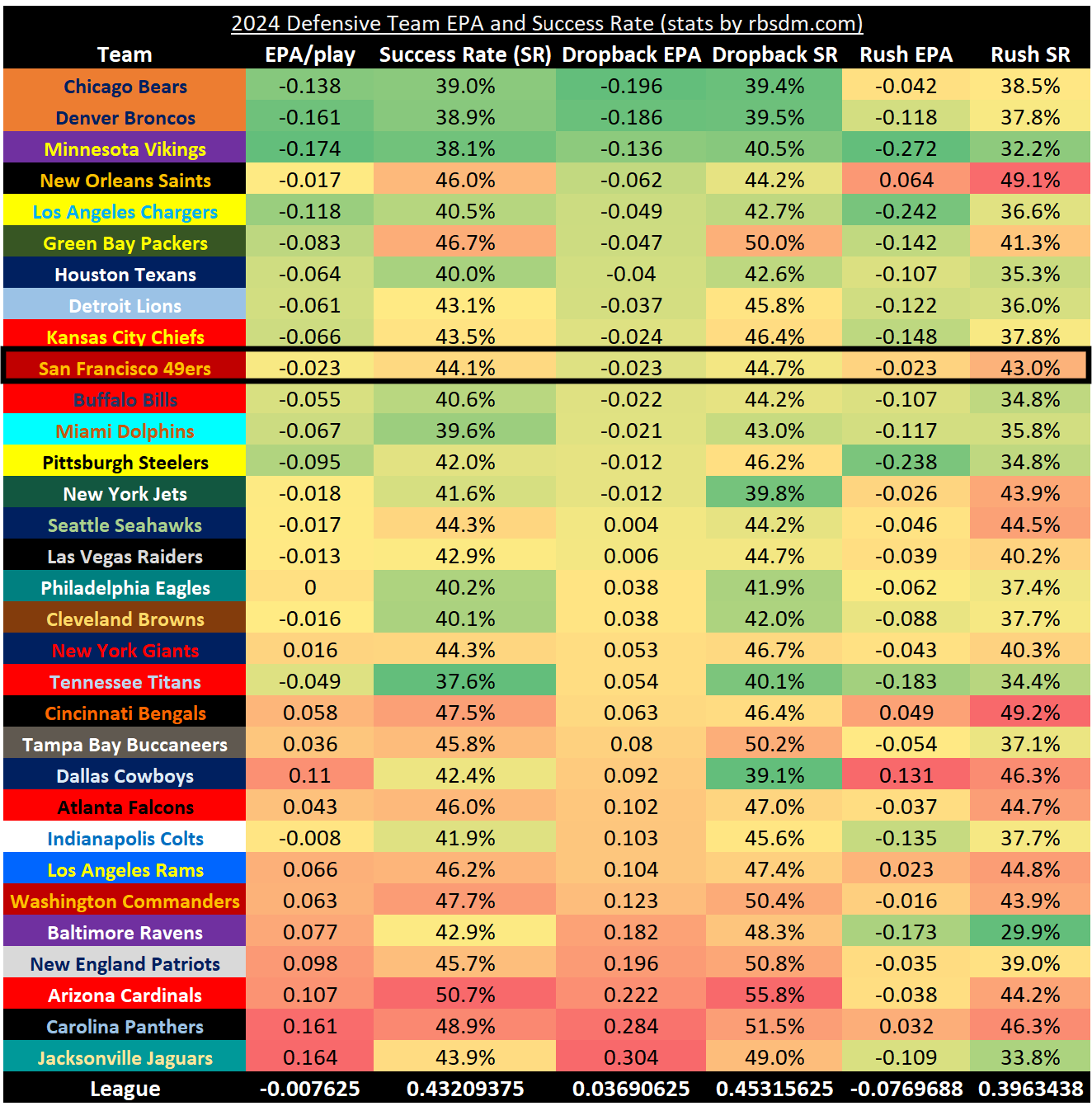
Where the 49ers can be beaten is in the run game. Quiet as it’s kept, they are just 26th in EPA per rush allowed and are 22nd in defensive success rate on rushes. The problem for the Cowboys is their ability to exploit this weakness; Dallas ranks dead last in team rushing per game. Rico Dowdle has been better than Ezekiel Elliott but is not useful, ranking 33rd in expected points (EP) per game and 35th in FPOE per game. It is rumored Dalvin Cook will be active for the first time this season, but he was worse with the Jets last year than Elliott has been with the Cowboys this year; don’t hold out too much hope.


